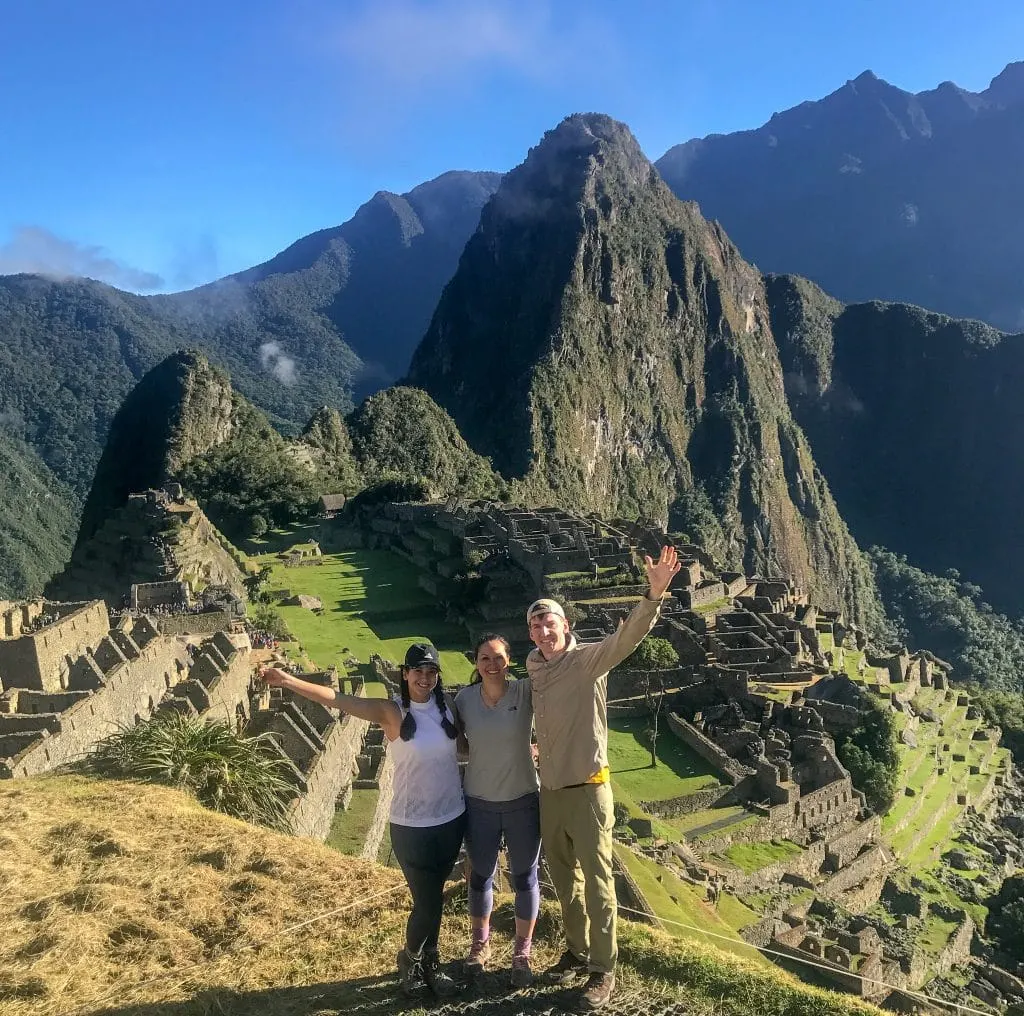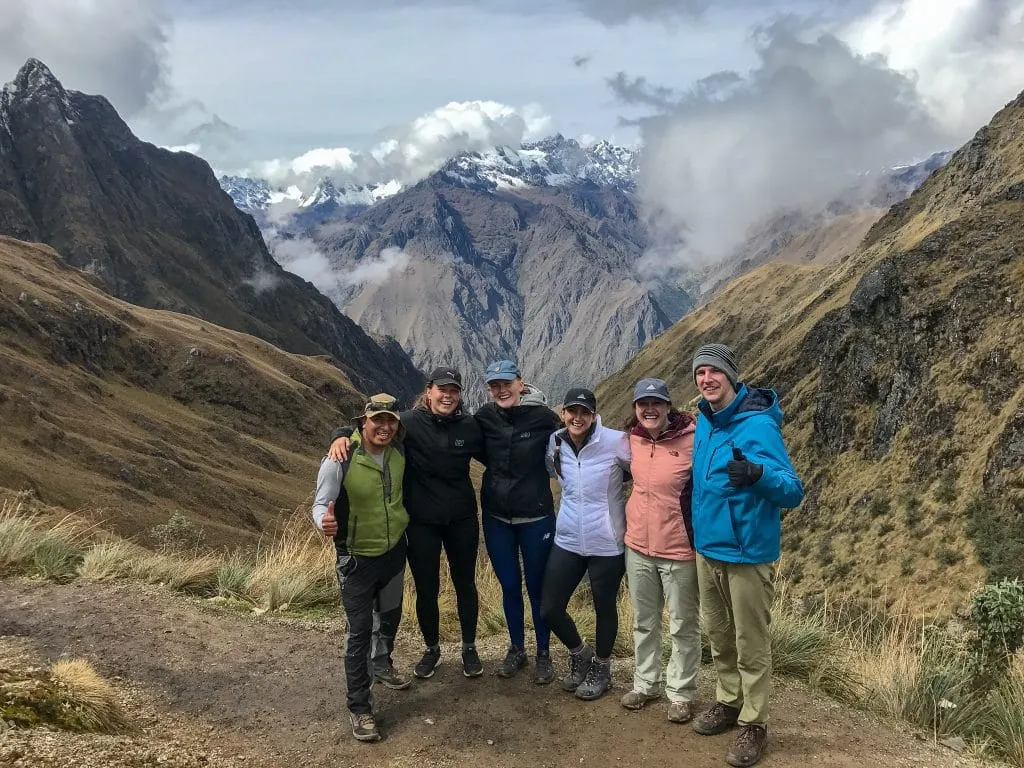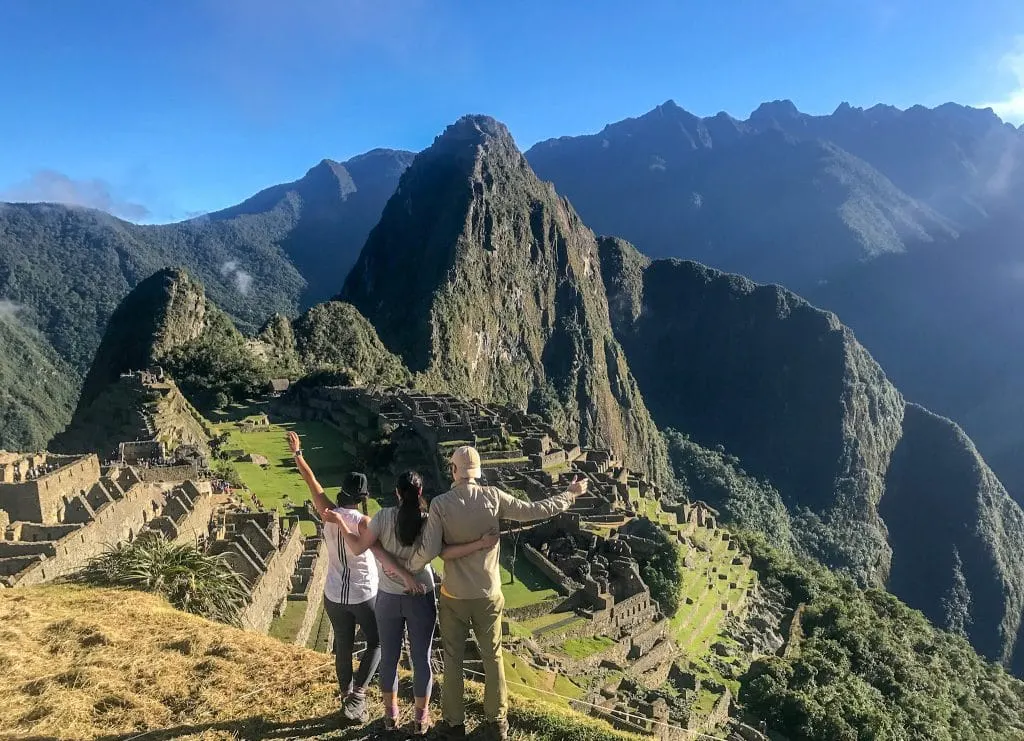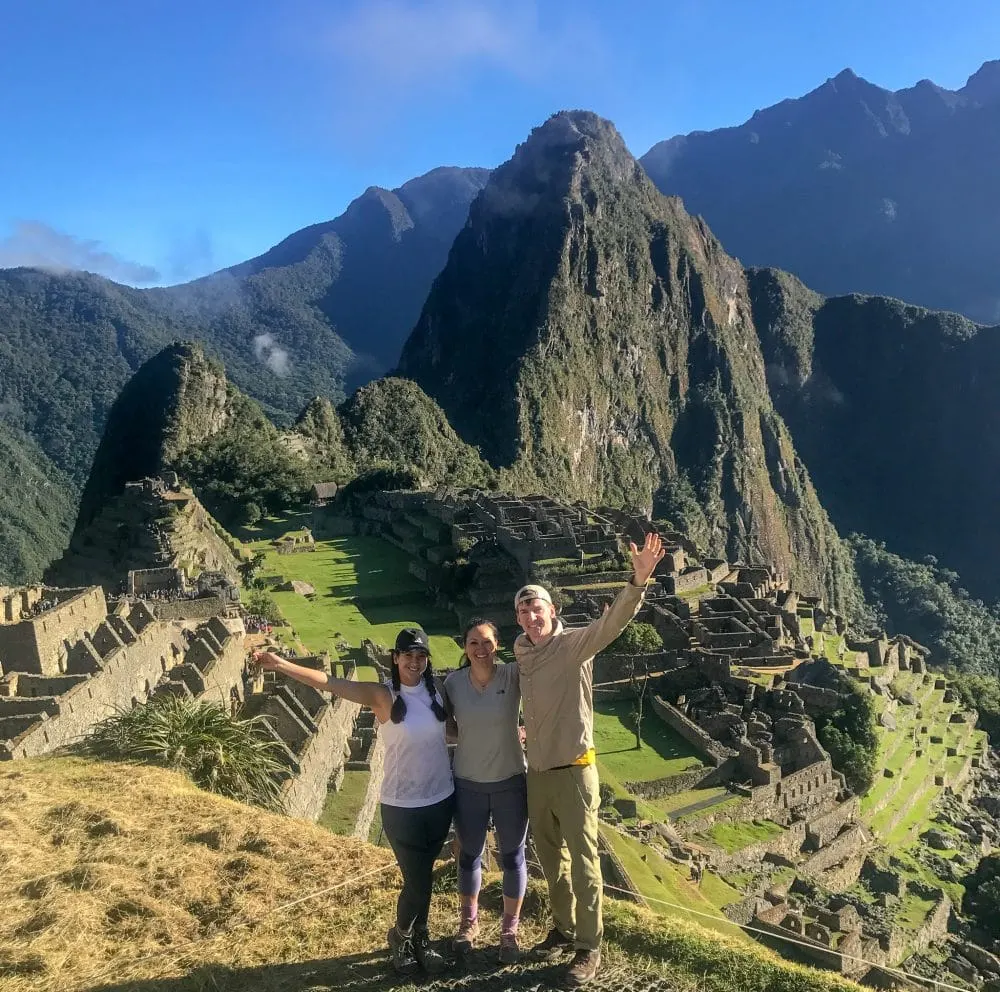Are you prepared to get Machu Picchu Body Ready? Then you have come to the right place. I have the perfect and easy to follow guide on training for the Inca trail.
Trekking for six to eight hours a day at a high altitude for four days is not an easy trek, so training is highly recommended. Hiking the Inca trail should be enjoyable, not sufferable, which is why getting fit is key. When you are training for the Inca trail, you must focus on three areas: cardio, light weight lifting, and mind over matter. It is also something you must start preparing for months in advance. Our guide on training for the Inca trail will definitely help you become fit and successful on the hike. Whether you follow our guide completely or take bits and pieces, we are confident you will be well prepared to hike the Inca trail to Machu Picchu.
An Intro to Training for the Inca Trail
We were excited to begin training for the Inca trail because it was our excuse to actually start working out and taking better care of ourselves. We figured that after we trained for six months, naturally we would continue. Sadly, we did not. We got fit enough for our trek, but have yet to work out again. If Machu Picchu cannot keep us in shape, we don’t know what will! Shelby (Christina’s little sister, AKA our editor) on the other hand, she has been able to remain in shape by continuing her workouts. So after you finish our guide on training for the Inca trail, you can be like us or you can be like Shelby. Regardless of which path you take, you will be fit for the Inca trail!
The workouts should start off easy and progress into longer and harder workouts. One of the most important things to remember, DO NOT OVERWORK YOUR MUSCLES! Your hike will be ruined if you push your body over the limits and pull a muscle. So start slow and increase your workouts when you see fit.
Lastly, our guide is meant to help anyone with or without gym access. We will do our best to mention different ways to train that can be accessible to everyone.

How Many Days a Week Do I Train?
Training for the Inca trail should start at least four to six months before the hike. The first month you begin training for the Inca trail, you should work out three times a week. You can slowly progress up to five days a week, but it is up to you. We (Adam and Christina), only worked out three times a week for six months and we felt fit during the hike. Shelby would work out anywhere between four to five times a week and she was more than fit, she was always at the front of the pack.
Everybody is different, so you truly need to do what’s best for you. For us, training three times a week was hard enough on our busy schedules. In addition, we have a long history of being soccer players, so when we participate in athletic activity, it is easy to bounce back into our athleticism. Whereas, if someone has never worked out or hates cardio, then they would need to work out more than three times a week. Each person’s body is different and should use this guide to your comfort and needs to improve your hiking fitness.
Cardio Training for the Inca Trail
Cardio or aerobic exercises is the number one area to focus on when you are training for the Inca trail because a strong cardiovascular system can process oxygen at a better rate. Each day you work out should involve cardio. We would typically do cardio with abs or light weight lifting and stair steps. If you have the capability of using aerobic machines to build your cardio, try incorporating interval programs. The Inca trail consists of continually hiking up steep trails and then descending down them multiple times a day. This is why we recommend working out in intervals when training for the Inca trail. Also, push yourself at a high incline or faster pace than slow down and lower the incline repeatedly for a designated time.
Your cardio training can include any aerobic activity such as walking on an incline (on a treadmill or a nearby hill), running on the elliptical, riding the bicycle, swimming laps, etc. Our favorite ways of cardio training were walking up our apartment’s 16 flights of stairs, jogging on the Cybex Arc Trainer and hiking at nearby parks.
Stair tip: If you are going to walk up flights of stairs, we recommend progressing to walking on every other step. This practice will make you more than prepared to walk up the extremely steep Inca steps. In addition to your daily workouts, if you come across an opportunity to take stairs than the elevator, definitely choose the stairs. Since we began training for the Inca trail back in January, we rarely ever use an elevator.
Walking at an incline is one of your best options because at least half of the Inca trail consists of walking up steep trails. To challenge yourself, walk at the highest incline possible at a reasonable speed. If you do not have access to a treadmill, find a hill nearby that is as steep as possible.
Lightweight Lifting is Key
Lightweight lighting while building your stability will help tremendously during the Inca trail hike. For four days you will be carrying a backpack from anywhere between 4-10 pounds. That means your going to need a strong lower back, core, and shoulders. In addition, your legs will need to be in shape for the steep inclines and thousands of Inca steps you will trek. Your quads, hamstrings, calves and gluteus maximus should be your main focus of strengthening.
Everything should be lightweight lifting and if possible, incorporating cardio. That means lifting heavy weights in the gym is unnecessary and incorrect when training for the Inca trail. Why? Because you want to always be building cardio and strengthening the body not getting ripped. An example of light weight lifting is fast squats with 25 pounds, rather than slow and low squats with 200 pounds.
Another great exercise to incorporate in your training for the Inca trail is one-legged squats because you have to focus on your balance and strength. When you are squatting with one leg, you are strengthening not only your leg muscles but also your core. Working on your stability is important because trekking with a heavy backpack on various rocks and steep steps require great balance. In addition, not all of the rocks are even stable, so having a great core balance is important or you can easily fall and twist an ankle.

Training Your Mind Over Matter
Of course, being fit is important to hike the Inca trail, but half of the battle is mind over matter. It is very important to include this section when training for the Inca trail because your mind is a powerful tool. When you are on the hike and think you cannot make it one more step, it’s your strong mind that must make you move your muscles.
Training to have a strong mind over matter is not easy, but it basically comes down to pushing yourself past your limits. Every day you are working out, set a new goal for yourself that may slightly be out of reach. For example One day you run on the elliptical for 20 minutes and it was already difficult, so on the next day set your new goal to 25 minutes. In that 20 – 25 minutes if you feel yourself fading and wanting to quit, that is when you must keep going! Then when you hit that 25-minute goal mark and your body and mind are telling you, “great job, you finished,” you go two more minutes. Those two extra minutes past your goal is what’s going to help you when you are ascending Dead Women’s Pass.

Our 6 Month Workout Regime for the Inca Trail
As we said in the beginning, you do not need to follow this word by word. You can use this as a guideline or adjust to what best fits your needs. We even used this workout regime for the Inca trail as a guideline and would stray away from it every once in awhile. The result? We conquered the Inca trail with no sweat.
When you do a light cardio day, focus on leg day because light weight squats and lunges should naturally incorporate cardio. Then when you are working on step aerobics, focus on your core and upper body. Always remember to stretch before and after your workouts! Find the method of cardio that works for you.
Christina would jog on the elliptical or Cybex Arc Trainer at an incline. Adam would walk on the treadmill at an incline or ride the bicycle. Shelby would jog on the treadmill or walk at a high incline. For stair aerobics, Christina and Adam would walk up 16 flights of stairs starting at 2 sets and progressing to 4 sets. Shelby would use the StairMaster beginning at a medium level then increasing the levels at intervals. Once you start to become comfortable with stairs, start wearing a backpack with the weight you will carry (between 4-10 pounds).
Month 1
Week 1: Train three days a week
- Strength Training:
- 15 Lunges – 2 sets
- 15 bodyweight squats – 2 sets
- 15 Lying leg curls – 2 sets
- 15 Sit-ups
- 25 Russian Twist (or your favorite ab workout)
- 10 Shoulder presses
- 10 Back and shoulder flies
- 10 Push-ups
- Aerobic Training:
- Jog with the desired method for 1 mile
- Step aerobics – 10 mins
- Stretch:
- Basic stretching for arms, legs, back, stomach
Week 2: Train three days a week
- Strength Training:
- 15 Lunges – 3 sets
- 15 bodyweight squats – 3 sets
- 15 Lying leg curls – 3 sets
- 20 Sit-ups
- 30 Russian Twist (or your favorite ab workout)
- 15 Shoulder presses
- 15 Back and shoulder flies
- 15 Push-ups
- Aerobic Training:
- Jog with the desired method for 1.5 miles
- Step aerobics – 15 mins
- Stretch:
- Basic stretching for arms, legs, back, stomach
Week 3: Train three days a week
- Strength Training:
- 20 Lunges – 3 sets
- 20 bodyweight squats – 3 sets
- 20 Lying leg curls – 3 sets
- 25 Sit-ups
- 40 Russian Twist (or your favorite ab workout)
- 10 Shoulder presses – 2 sets
- 10 Back and shoulder flies – 2 sets
- 10 Push-ups – 2 sets
- Aerobic Training:
- Jog with the desired method for 2 miles
- Walk on the treadmill for 20 minutes
- Step aerobics – 20 mins
- Stretch:
- Basic stretching for arms, legs, back, stomach
Week 4: Train three days a week
- Strength Training:
- 20 Lunges – 3 sets
- 20 bodyweight squats – 3 sets
- 20 Lying leg curls – 3 sets
- 10 each leg One legged squats – 2 sets
- 30 Sit-ups
- 45 Russian Twist (or your favorite ab workout)
- 12 Shoulder presses – 2 sets
- 12 Back and shoulder flies – 2 sets
- 12 Push-ups – 2 sets
- Aerobic Training:
- Jog with the desired method for 2.5 miles
- Step aerobics – 25 mins
- Stretch:
- Basic stretching for arms, legs, back, stomach
Month 2
Week 1: Train 3-4 days a week
- Strength Training:
- 15 Lunges – 4 sets
- 15 Lightweight squats – 4 sets
- 15 Lying leg curls – 4 sets
- 10 each leg One legged squats – 4 sets
- 35 Sit-ups
- 50 Russian Twist (or your favorite ab workout)
- 10 Shoulder presses – 3 sets
- 10 Back and shoulder flies – 3 sets
- 10 Push-ups – 3 sets
- Aerobic Training:
- Jog with the desired method for 3 miles
- Walk on the treadmill with an incline for 20 minutes
- Step aerobics – 30 mins with 5 pounds in a backpack
- Stretch:
- Basic stretching for arms, legs, back, stomach
Week 2: Train 3-4 days a week
- Strength Training:
- 15 Lunges – 4 sets
- 15 Lightweight squats – 4 sets
- 15 Lying leg curls – 4 sets
- 10 each leg One legged squats – 4 sets
- 40 Sit-ups
- 55 Russian Twist (or your favorite ab workout)
- 12 Shoulder presses – 3 sets
- 12 Back and shoulder flies – 3 sets
- 12 Push-ups – 3 sets
- Aerobic Training:
- Jog for 3.5 miles incorporate intervals
- Walk on the treadmill at an incline with intervals for 20 minutes or more
- Step aerobics – 30 mins with 8 pounds in a backpack
- Stretch:
- Basic stretching for arms, legs, back, stomach
Week 3: Train 3-4 days a week
- Strength Training:
- 20 Lunges – 4 sets
- 20 Lightweight squats – 4 sets
- 20 Lying leg curls – 4 sets
- 15 each leg One legged squats – 4 sets
- 45 Sit-ups
- 60 Russian Twist (or your favorite ab workout)
- 10 Shoulder presses – 4 sets
- 10 Back and shoulder flies – 4 sets
- 10 Push-ups – 4 sets
- Aerobic Training:
- Jog for 4 miles incorporate intervals
- Walk on the treadmill at an incline with intervals for 20 minutes or more
- Step aerobics – 30 mins or more with 8 pounds in a backpack
- Stretch:
- Basic stretching for arms, legs, back, stomach
Week 4: Train 3-4 days a week
- Strength Training:
- 25 Lunges – 3 sets
- 25 Lightweight squats – 3 sets
- 25 Lying leg curls – 3 sets
- 15 each leg One legged squats – 4 sets
- 50 Sit-ups
- 65 Russian Twist (or your favorite ab workout)
- 15 Shoulder presses – 3 sets
- 15 Back and shoulder flies – 3 sets
- 15 Push-ups – 3 sets
- Aerobic Training:
- Jog for 4.5 miles incorporate intervals
- Walk on the treadmill at an incline with intervals for 30 minutes or more
- Step aerobics – 40 mins or more with 10 pounds in a backpack
- Stretch:
- Basic stretching for arms, legs, back, stomach
Months 3-6
Continue to increase the sets, reps, and cardio each week. As the reps continue to increase remember to break the weight lifting into more than one day. So, if you can find time to train five days a week that is the best.
For example: Do a light cardio activity and then lightweight squats and one-legged squats on one day. Then step aerobics for 40 minutes followed by a core work out. On the third day of working out, walk on the treadmill for 30 minutes and then finish your leg workouts with lunges and leg curls. On the fourth day do more cardio of your choice and upper body workouts.
Final Notes when Training for the Inca Trail
As long as you maintain three to four days of cardio and light weight lifting, you will be fine. Also, remember that cardio does not always have to be boring, find ways to make cardio enjoyable by changing it up with hiking, swimming, etc. By the fifth month on training for the Inca trail, you should be able to jog for at least five miles. At this point, the rest of the training for the Inca trail becomes more mind over matter. If you can withstand five miles of cardio every week, you can definitely hike for 6 to 8 hours a day.

Looking for more posts on Peru? Check out these!
The Best Things to See During a Sacred Valley Private Tour
A Complete Guide to Hiking the Inca Trail to Machu Picchu
The Ultimate Packing Guide for Hiking the Inca Trail






Nicole
Wednesday 7th of September 2022
Starting to train now! Booked a tour for May next year. I had one question. In your breakdown's. Did you do all those activities in one workout? Or was one of the three days strength training, another aerobic like running and another stairs? Thanks!
Nicole
Wednesday 7th of September 2022
@oursweetadventures, thank you so much!
oursweetadventures
Wednesday 7th of September 2022
That’s awesome! I’m so excited for you! The hike is incredible and so rewarding.
To answer your question - no, we would do some strength training with some cardio/aerobic training. When you do a light cardio day, focus on leg day because light weight squats and lunges should naturally incorporate cardio. Then when you are working on step aerobics, focus on your core and upper body. Climbing stairs is a lot on the lower body, so I would do abs or arms if you want to combine some exercises.
I hope this helps!
Sharon Smith
Sunday 23rd of August 2020
Great workout suggetions, we are going to incorporate those into our preparations! You might also mention that you will be hiking at altitude, and if possible, find somewhere to do that as well. I'm in Arizona and am thinking that we should at least hike in the mountains. Ours are between 5000 and 7000 feet and I believe Machu Pichu is around 11,000? Something to consider. Thanks again, I enjoy your posts.
oursweetadventures
Monday 24th of August 2020
I’m so glad you enjoyed my post and tips. Hiking at a higher altitude will definitely be helpful to get a feel for the breathing environment but if it’s not every day or week, I do not think it would make a drastic difference in training. I think it’s awesome you will be able to train more at a higher altitude though! Best of luck and enjoy every moment of your hike to Machu Picchu!
A Complete Guide to Hiking the Inca Trail to Machu Picchu - Our Sweet Adventures
Saturday 10th of August 2019
[…] one. A lot of planning and preparation has to go into hiking the Inca trail to Machu Picchu, from training to a proper packing list, the weather, booking the Inca trail and more. With that said, after first […]
Emma
Saturday 28th of July 2018
wow thanks for this, didn't realise how much training was required for this hike!
oursweetadventures
Sunday 5th of August 2018
These are suggestions but the really important thing to remember is having the mental strength to keep going.
Amy
Saturday 28th of July 2018
These are some great tips and not just for Machu Picchu but also for any long hikes really! I hope to visit Machu Picchu soon so will definitely start following your work out!
oursweetadventures
Sunday 5th of August 2018
Let us know if you have any questions about the trail. Remember that much of this hike is as much about mental strength as it is about physical strength.